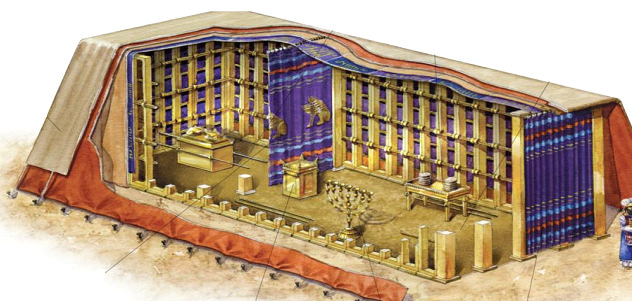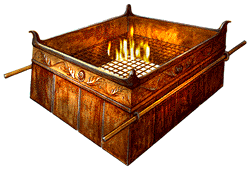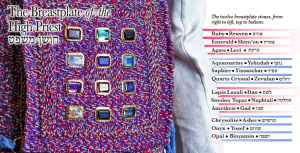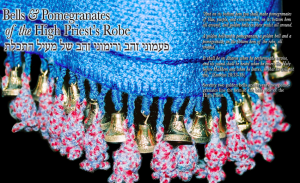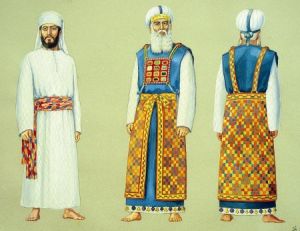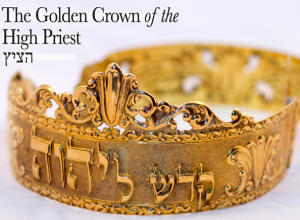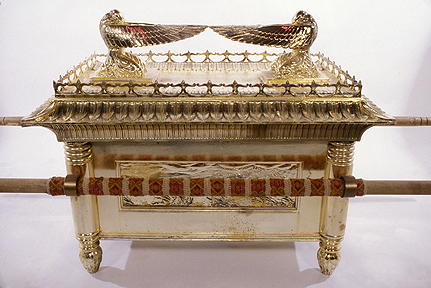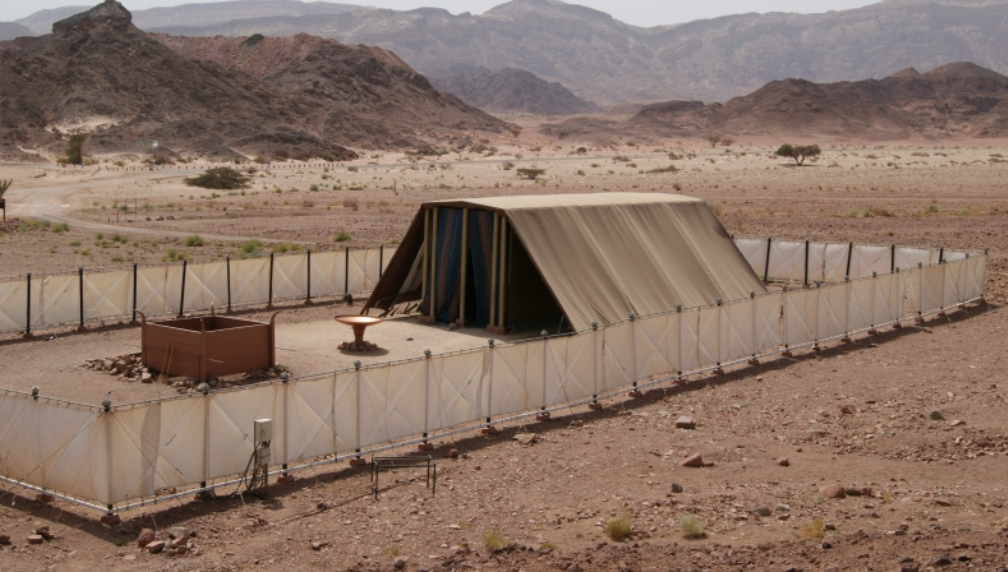פקודי
Parshat Pekudei
Shemoth (Exodus) 38:21-40:38
These were the appointments of the Dwelling Place, the Dwelling Place of the Witness, which was appointed by the command of Mosheh, for the service of the Lewites, by the hand of Ithamar, son of Aharon the priest. – Shemoth (Exodus) 38:21
The word פקודי Pekudei literally means “accounts.” Mosheh (Mushah) made פקודי Pekudei, an accounting of all the gold, silver and bronze that was used in the building of the Mishkan.
The gold of the offering was twenty nine talents, and seven hundred and thirty shekels, after the shekel of the sanctuary.
The Menorah (lampstand) and the Kaporet (Ark cover) were of solid gold. The Ark, Table, Golden Altar, and the Mishkan’s wall panels and posts were gold-plated. Gold thread was used with the fibers in the roof coverings, the Veil (Parochet), screens and the Kohen HaGadol’s garments.
The silver for the Mishkan was provided by the half-shekels funded by each of those who “went to be registered” which were 603,550 men over the age of twenty who were old enough for battle. This added up to 100 talents (a “talent” is around 150 lbs.) plus 1,775 shekels of silver . The hundred talents were used to make the hundred foundation sockets that held up the Mishkan’s wall panels and posts. The 1,775 shekels were used for hooks and fixings on the sixty posts, which enclosed the Courtyard.
The bronze calculated to seventy talents and 2,400 shekels. This was used to make the foundation sockets to the entry of the Tent of Meeting. The brazen altar and its grate and all the vessels of the altar; the foundation sockets of the court round about and the sockets of the court gate; including all the pegs of the tabernacle and all the pegs of the court round about were made of the collected bronze.
Bigdei Kahuna (Garments of the Priests)
And he made the Efod of gold, blue, and purple, and scarlet, and fine twined linen…
And he made the Breastplate… And they set in it four rows of stones… enclosed in fixtures of gold in their settings. And the stones were according to the names of the children of Israel, twelve, according to their names
And he made the Cloak of the Efod of woven work, all of blue… And they made upon the hems of the Cloak pomegranates of blue, and purple, and scarlet, and twined linen. And they made bells of pure gold, and put the bells between the pomegranates upon the hem of the robe…
And they made tunics of fine linen of woven work for Aharon, and for his sons; and the turban of fine linen… and linen pants of fine twined linen; and a sash of fine twined linen, and blue, and purple, and scarlet, the work of an embroiderer; as YaHuWaH commanded Mushah.
And they made the plate of the holy crown of pure gold, and wrote upon it an inscription, like the engravings of a signet, “Qodesh unto YaHuWaH.” And they tied to it a lace of blue, to fasten it on the turban above; as YaHuWaH commanded to Mushah.
Assembly of the Mishkan
Mushah looked upon the work they had accomplished and saw that the work was exactly as YaHuWaH commanded, therefore he baruch (“blessed”) the workers. Mushah commanded that the Mishkan (dwelling place) be erected on the first day of the first new moon, which happens to be the month or moon cycle of Abib (Aviv), the first month of YaHuWaH’s calendar.
And Mushah erected the Tabernacle, and fastened its sockets, and set up its wall panels, and put in its bars, and reared up its pillars.
And he spread the tent over the Mishkan, and put the covering of the tent above upon it; as YaHuWaH commanded Mushah.
And he took and put the [Tablets of] Testimony into the Ark, and set the carrying poles on the Ark, and put the Kaporet above upon the Ark. And he brought the Ark into the Tabernacle, and set up the Veil of the screen, and screened the Ark of the Testimony; as YaHuWaH commanded Mushah.
And be put the Table in the Tent of Meeting, upon the northward side of the Tabernacle, outside the Veil. And he set the bread in order upon it before YaHuWaH; as YaHuWaH had commanded Mushah.
And he put the Menorah in the Tent of Meeting, over against the table, on the southward side of the tabernacle. And he lighted the lamps before YaHuWaH; as YaHuWaH commanded Moses.
And he put the Golden Altar in the Tent of Meeting before the Veil: and he burnt sweet incense upon it as YaHuWaH commanded Mushah.
And he set up the Screen at the door of the tabernacle. And he put the Altar of Burnt Offering before the door of the Tabernacle… and offered upon it the burnt offering and the meal offering; as YaHuWaH commanded Mushah.
And he set the Basin between the Tent of Meeting and the altar, and put water there, for washing…
And he erected the Court round about the Tabernacle and the Altar, and set up the screen of the court gate. And Mushah finished the work.
When Mushah was finished he anointed (Mashyach) the tent and all it’s components. The word Mashyach in Hebrew means anointed and the word Mishcah literally means anointing. Yahuwshuwa is called Mashyach which was rendered Messiah because he too will be anointed with the Qodesh anointing oil! This also proves that all elements of the tent in the wilderness points to the future “anointed one” , Ha’Mashyach, The Messiah.
The indwelling
Shemoth (Exodus) 40:34And the cloud covered the Tent of Meeting, and the esteem (kabod) of YaHuWaH filled the Dwelling Place.35 And Mushah was not able to come into the Tent of Meeting, because the cloud dwelt on it, and the esteem (kabod) of YaHuWaH filled the Dwelling Place.36 And when the cloud was taken up from above the Dwelling Place, the children of Yashar’al (Yisrael) went onward in all their journeys.37 But if the cloud was not taken up, then they did not set out till the day that it was taken up.38For the cloud of YaHuWaH was on the Dwelling Place by day, and fire was on it by night, before the eyes of all the house of Yashar’al (Yisrael), in all their journeys.
The word Mishkan comes from the root word lishkon which means to rest. The Mishkan is the resting place or literally dwelling place of YaHuWaH. The vision Mushah was given on the mountain was the vision of YaHuWaH’s Mishkan (dwelling place), which is in Shamayim (heaven/space). If we are to be a “kingdom of kohanim (priests)” as written in both the TaNaKh and Brit Chadasha (Renewed Covenant) we must understand the dwelling place of YaHuWaH and all of his righteous ordinances. In this way we can experience Ha’Kabod meaning the esteem, dignity or honor. This word has historically been translated into English as “glory.” The word Kabod’s origin means heavy. This essentially depicts the presence of YaHuWaH being heavy, which can be felt and experienced. The text tells us that the kabod was so great that Mushah could not remain in the tent. The ideas of honor, esteem and integrity are amongst the most weighty principles of life and are the expression of the Torah. We who are flesh and bone are tents, made not with human hands but by the design of YaHuWaH. Man is made in the image of Elohim according to the very first chapter of Torah, therefore it is befitting that we should be an expression in this tangible world of the Infinite One. For this reason YaHuWaH places his Ruwach Ha’Qodesh (set apart wind/breath/spirit) upon men and women who diligently seek him. Only by the gift of YaHuWaH can man truly walk in honor. This Torah portion teaches us that our Creator longs to have his habitation among his people. We see that YaHuWaH wants to be the center of our camp, therefore the center of our hearts, minds and deeds. One day soon, the reign of YaHuWaH will be established on the earth, his Messiah shall teach from Tsyion and the esteem of YaHuWaH will once again tabernacle with his beloved ones.


